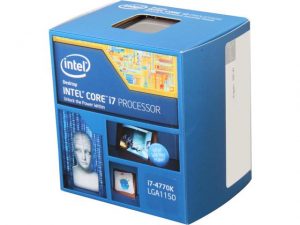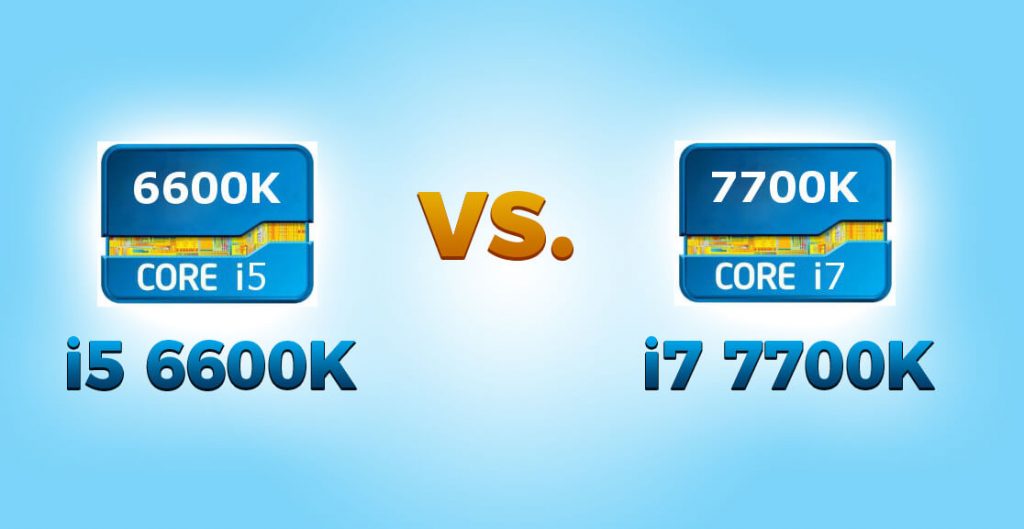i7 4770K vs i7 7700K Intel Core CPU Comparison Review
At the first sight, these two processors look identical. They are both made by Intel and they are both i7 units. But, if we take a closer look under the hood, we will see plenty of differences. So, in the i7 4770k vs i7 7700k battle, which is better? We tested and compared both processors and determined that after all, only one can be a winner.
Similarities between i7 4770K vs i7 7700K
As we have mentioned at the beginning, these two processors do have a few similarities. Both of them are newer generation units (not the same generation though), both are designed for desktop computers and both of them are i7 meaning that they have 8 cores or threads to use. Cores are the main element of each processor. In simple terms, they determine the power of the microprocessor, which is directly related to the ability to complete multiple tasks as soon as possible. However, not all cores work on the same frequency, meaning that some processors work faster than the others, despite the same number of cores.
Another and the last similarity is in the L2 and L3 cache. Both models have 2MB of L2 cache and 9MB of L3 cache. Just to add, these values are above average and usually reserved for expensive, high-end processors. We liked the cache capabilities both models use and obviously, there are no differences here.
 |
 |
| Intel Core i7-4770K | Intel Core i7-7700K |
| 8.2/10 | 9.5/10 |
 |
 |
Introducing the Intel i7 4770K
First of all, in the i7 4770k vs i7 7700k analysis, the 4770k unit is more affordable. Still, it works at 3.4GHz in a normal regime, which is a decent score and probably suitable for most of you. When turbo mode is activated, the working frequency will be increased up to 3.9GHz. Keep in mind that a processor rarely uses the turbo mode, which by the way increases the power consumption. However, i7 4770k is more likely to use turbo mode due to lower operating frequency.
Thermal design power is 84w and it is actually lower than another processor has to offer. This simply means that it uses less energy to operate. Furthermore, the lower energy means that a processor generates less heat. This is standard for processors developed for home-related purposes.
Advantages
- Intel i7 4770k needs less power to operate and it generates less heat
- It is more affordable than the second unit on the test
Disadvantages
- Lower memory bandwidth
- Clocking is possible, but it won’t give some impressive results.
Intel i7 7700K and what it has to offer
Intel i7 7700K is a high-end processor designed for demanding users. If you are a gamer or you need a computer to run the advanced and demanding software, this processor is just right. It is also based on the latest generation and truly has plenty to offer. Let’s begin with operating frequency. It is 4.2GHz, which is above average, but when the turbo mode is activated, the operating frequency will jump to 4.5GHz. If you are curious about the operating frequency on the i7 4770k vs i7 7700k test, keep in mind that 7700k model uses a higher value.
Clocking is an interesting advantage that must be mentioned. This model is already known for superior overclocking capabilities, which is perfect for gamers. At the moment, you won’t have a need to clock this processor, but in the near future, if you want to play a new game, you may have to increase the frequency.
Thermal design power of the i7 7700k is 91w, or in other words, 7w higher than the previous processor had. The maximum temperature it can withstand is 100 degrees Celsius (4770k can withstand 72.72 degrees Celsius). Just to add, when you clock a processor, it will generate more heat! As you can see the 7700k is capable of withstanding overclocking demands.
Advantages
- Higher operating frequency
- Better clocking possibilities
- Better memory bandwidth
Disadvantages
- More expensive
- Uses more energy
In-Depth look at i7 4770K vs i7 7700K
We will want to add that the i7 4770k has Haswell microarchitecture and the technology used is 0.022 microns. The socket is 1150 and the clock multiplier is 34.This processor was launched in 2013 and back then it is considered as one of the most desirable processors. There is no need in telling you that it uses 64-bit technology. Back then, it was a popular processor for games.
The fun begins with the i7 7700k. The microarchitecture is Kaby Lake and the used technology is 0.014 microns, which is better that with the previous model. The socket it uses is 1151, also newer than the 4770k. Clock multiplier is 42 if you may wonder. This processor was launched in 2017 (January) so it is still a new processor.
Verdict – i7 7700K is the best Processor!
So, which one is better? On our i7 4770K vs i7 7700K test, we determined that the i7 7700K is a much better choice. It is newer, faster and more powerful processor suitable for demanding users, who will need the extra speed. There is no need in mentioning that gamers will appreciate this unit and they will be completely satisfied with it. Yes, it still uses more energy, but the results are phenomenal. It outruns the other competitor in any aspect we compared them. Furthermore, it is more expensive but this difference is minor and it doesn’t have to be even mentioned. Users will be able to use this processor for a few years without an issue.
Intel i7 4770K was a great processor but now it isn’t! Still, if you are looking for a unit which is reliable, use less energy than all-new processors, this one isn’t a bad idea. It still can be used for most software and for average computers. But, if you are a gamer, or planning to become one, this processor isn’t a wise decision.
The bottom line is that the i7 7700K is the absolute winner. It isn’t only better than the i7 4770K, but many other processors you can find today. Probably better than a processor you are currently using.
 |
 |
| Intel Core i7-4770K | Intel Core i7-7700K |
| 8.2/10 | 9.5/10 |
 |
 |






